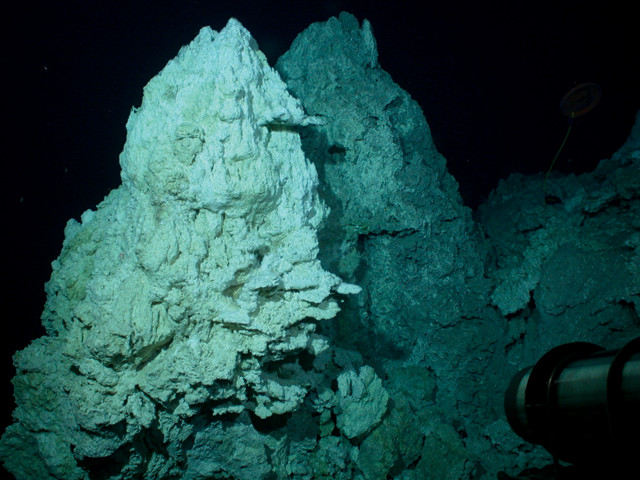
by Bethany Augliere Wednesday, February 13, 2019

A carbonate chimney observed in 2005 at the Lost City hydrothermal vent field. Researchers recently determined that an amino acid detected in rock deep below the field was likely formed through abiotic processes, shedding light on how early biomolecules might have first formed. Credit: NOAA.
In 2000, scientists discovered a new type of deep-sea hydrothermal vent site in the North Atlantic about 20 kilometers west of the Mid-Atlantic Ridge, which they named Lost City. Nearly two decades later, researchers have discovered that an amino acid detected in rocks beneath the site is produced by a geochemical process, rather than a biological one. The find reveals conditions that might have kick-started life on Earth.
Unlike the more familiar “black smoker” chimney vents — which occur near volcanically active areas and emit dark plumes laden with metals and sulfide minerals leached from the seafloor by hot, acidic fluids — the Lost City hydrothermal vents are powered by serpentinization. In this process, minerals in the abundant mantle rock peridotite are chemically altered through reactions with water and converted to serpentinite, with heat and hydrogen produced as byproducts. At Lost City, the result is an underwater hot spring of methane- and hydrogen-rich alkaline fluid, as well as large white calcium carbonate towers. Although amino acids have been found before in hydrothermal fluids emerging at Lost City, the origins of the molecules were unknown.
Bénédicte Ménez, a geomicrobiologist from Paris Diderot University working at the Paris Institute of Earth Physics in France, and her colleagues found the amino acid tryptophan in samples recovered from almost 175 meters below the seafloor at Lost City. “We found organic carbon within these rocks and initially we thought it was the result of the presence of microbes,” says Ménez, lead author of a new study in Nature reporting the find. “But in the end, all the proof we accumulated told us a different story.”
To analyze their core samples, the team used three high-resolution imaging techniques, each of which turned up evidence of tryptophan inside nanopores in iron-rich clay minerals. But they didn’t find any traces of biomarkers, the remnants of molecules that are usually associated with biological cells, Ménez says, so the team ruled out a biological process as the explanation for the tryptophan. She and her colleagues propose that during serpentinization, iron-rich clay called saponite might be involved as a catalyst in chemical reactions that produce tryptophan.
“Tryptophan is one of the most complicated amino acids, so it’s difficult to imagine it being formed through a simple reaction,” Ménez says. That’s why it took a “long time to build a story strong enough to convince people.”
“This study was executed beautifully,” says Alexis Templeton, a microbial geochemist at the University of Colorado Boulder, who was not involved in the study. “The authors applied powerful spectroscopic techniques at the nano- and microscale to identify organic compounds trapped within the mineral matrix of subsurface serpentinites. They revealed the presence of molecules of great importance to prebiotic chemistry,” Templeton says.
The next steps in this work should look to confirm that the tryptophan from Lost City was indeed generated through a chemical process, says John Baross, a microbial oceanographer at the University of Washington who was not involved in the study but wrote an accompanying commentary about it. This can be done, he says, by analyzing the chirality of the amino acids collected. Some molecules can exist in two mirror-image, or chiral, forms that are chemically identical except for the orientation of certain atoms within the molecular structures. When a chiral molecule is synthesized via a nonbiological process, the result is equal proportions of both forms, while biological processes generally result in a higher proportion of one form or the other.
The implications of the work are exciting for researchers in the field. “This work moves the field forward by changing our conceptions of what molecules were available to support the earliest metabolisms,” Templeton says.
“Serpentinization was very common during the time when life is thought to have originated,” Baross says. If the production of tryptophan through serpentinization is confirmed, then serpentinization “may have played an important role in the origin of life and/or as the early environmental setting for the earliest microbial communities,” he adds.
“This is the first proof we have that amino acids can be formed through a purely chemical process on Earth,” Ménez says. And while it’s not proof that this process formed the very first cells, she says, it’s a step toward figuring out “how an inorganic world turned into an organic — and then a living — one.”
© 2008-2021. All rights reserved. Any copying, redistribution or retransmission of any of the contents of this service without the expressed written permission of the American Geosciences Institute is expressly prohibited. Click here for all copyright requests.